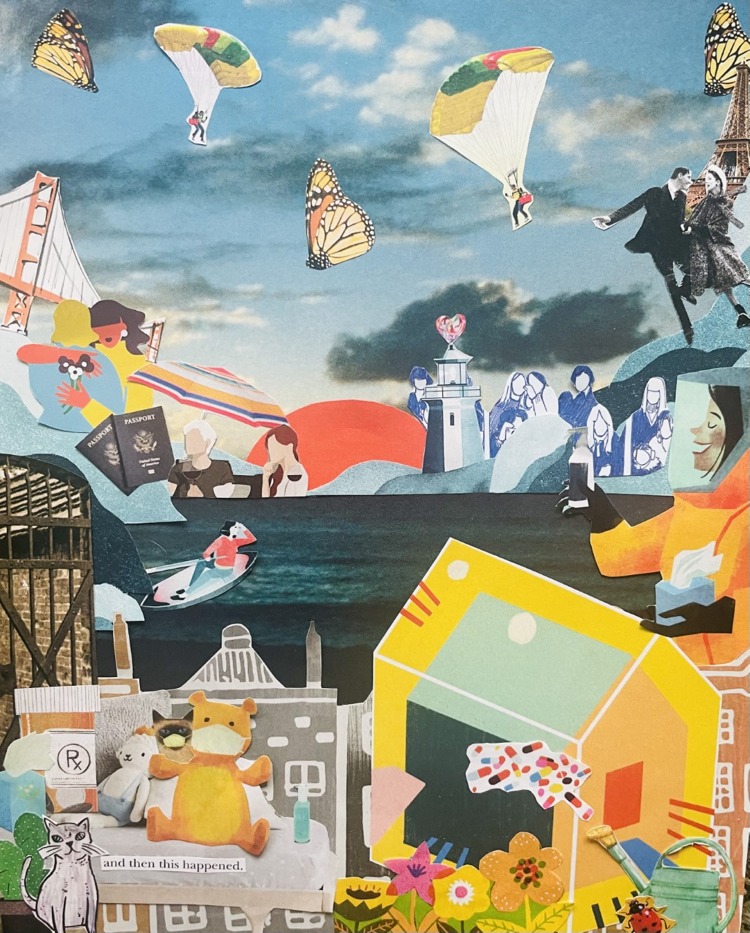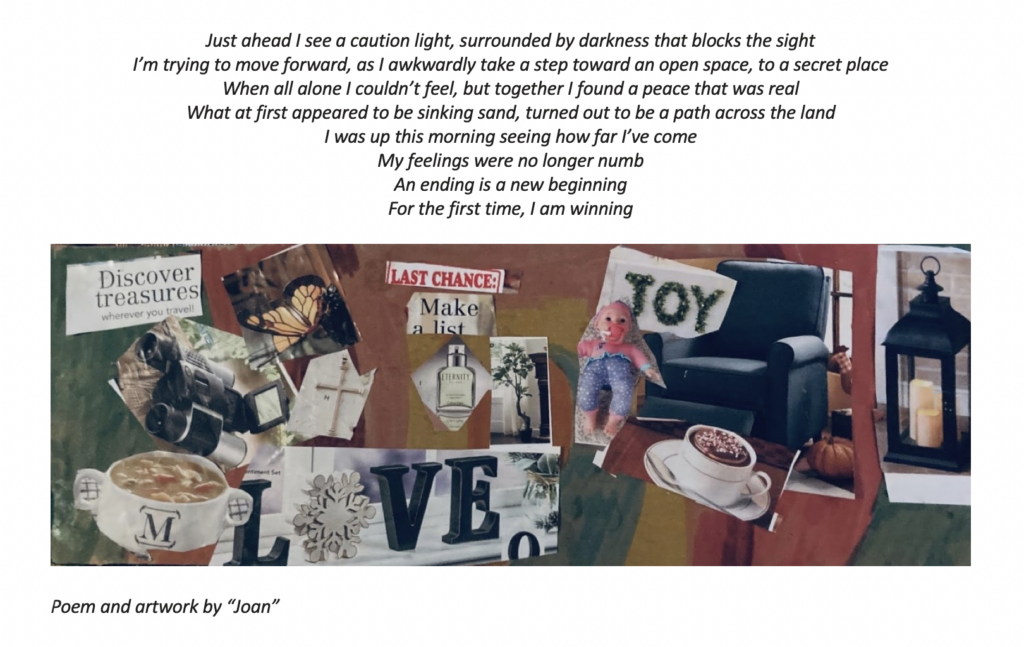
The Arts and Healing (Part 2 of 6)
Guest Blogger: Lacy R. Vitko, MA, ATR-BC
This blog series will examine the many roles the arts have in healing. Today we hear from Lacy Vitko, the Expressive Arts Administrator at Community Support Services.
Art: Mental Health’s Greatest Ally
In my role at Community Support Services (CSS), where I have been providing art therapy for nearly six years, I’ve had the privilege of working with extremely creative adults who live with severe and persistent mental illness. The challenges they face present within a myriad of symptoms and behavioral presentations, depending on a variety of contributing factors such as diagnosis, trauma history, comorbidities such as substance abuse or medical problems, and many others. I’ve witnessed and supported individuals transitioning from homelessness, getting off drugs and alcohol, and experiencing active psychotic episodes. I’ve also seen clients get the treatment they need to recover and better their lives, all while connecting with and expressing from, the artist within.
Art therapy is the therapeutic use of art-making, within a professional relationship, by people who experience illness, trauma, or challenges in living, and by people who seek personal development. (American Art Therapy Association, Guidelines for Insurers, 2012). As master’s level mental health professionals, art therapists are trained in visual art, counseling theories and techniques, and art therapy application, are represented by the American Art Therapy Association, and receive credentialing through the Art Therapy Credentials Board. There are a variety of ways art can be integrated into therapy, but the foundational component that differentiates art therapy from art class is that art therapy art is about the process, not the product. Regardless of the population seeking services, or therapeutic modality used, art can provide an opportunity for individuals to explore reasons for treatment, reduce anxiety about treatment, identify therapeutic goals and steps to achieving them, identify strengths and coping skills, and express feelings non-verbally in a safe and supportive environment. Art therapy does not require past experience in art making, or any “perceived” talent.
The way that art has been integrated in client treatment at CSS has developed and transformed over the years. It is first and foremost always about meeting an individual where they are, and working within their individual, clinical needs. Building rapport and relationship involves time and trust, and art is a valuable tool in this establishment. Even simple use of art materials such as colored pencils or markers in a dyad exercise between art therapist and client can help develop a connection in a way that words alone cannot. Sessions can evolve to help an individual improve self-esteem through learning how to use new materials and techniques, decrease symptoms by using art-making as a healthy distraction and provide purpose, or healing from past trauma by using the creative process as a way to share and process painful memories that previously were kept dormant. Art therapy groups provide peer group support while also offering the communal empowerment that comes with making art with others. A sense of hope develops by reducing isolation and building community utilizing a shared experience such as art making. Art has a way of breaking through to the subconscious, allowing new pathways for insight and behavior change.
Community art shows can also bring a sense of unity among client artists and gives them something to work towards as a goal. Annually, CSS hosts the Art of Recovery, a fundraiser art show open to all clients of the agency that invites the submission of two and three dimensional artwork for a juried exhibition. The opportunity to share their artwork with the larger community brings a sense of pride and accomplishment. This past year we were challenged the week of our scheduled event (slated to host over 300 guests) to transition to an online platform due to COVID-19 becoming a new part of our social existence. To our surprise and delight the online event was a huge success, including a virtual auction that successfully sold 51 of 58 pieces of artwork available. With clients receiving 75% of the profits, this brought an added representation of just how impactful the art and artist’s stories were, and will continue to be.
The onset of the pandemic has presented challenges for all, but particularly for in-person providers such as mental health professionals. Art therapy especially has been a modality that calls for art therapist and client to be in the same space to ensure art material access. Moving to Telehealth required the distribution of materials to client homes and the utilization of an internet-based service that many of our clients do not have access to. The process required creativity in itself in order to continue to provide art therapy. Over the past nine months, clients, along with myself, have been pushed to adapt, digging deep to find resilience, patience, and humor. Nothing seems to look like it did back in March, and people seem to be struggling mentally and emotionally more than ever. The sense of isolation for many has become the most difficult part of social distancing, and therefore, any connection becomes a lifeline.
Art therapy continues to be a resource for individuals struggling with severe and persistent mental illness. For a client named “Joan,” engaging in writing poetry and making art has been a source of motivation and purpose. Her weekly art therapy sessions provide her with the accountability and support to continue pursuing her creative outlets, even in the face of apathy and boredom. Her words and images capture thoughts and feelings that express her personal narrative in her own healing journey. She recently wrote a poem and created a collage to communicate the progress she has made in over a year of art therapy treatment, along with additional intensive treatment services at CSS (see below). Receiving positive feedback and encouragement, Joan continues to learn more about herself and her recovery.

I have faced my own struggles as a mental health professional since COVID-19 became a background to every day experience. Creating my own art has transformed from being an outlet that happens “when I have time,” to a daily practice of self-care. In order to ensure that I have the capacity to hold another’s pain, fears, and struggles, I have to be able to sit with my own. It has been a moment-to-moment practice of learning to “sit comfortably in the uncomfortable,” a phrase I heard repeated over and over again in graduate school. Collage has become the containment for all that encompasses my own discomfort. Regular engagement in art-making has helped keep me attuned to my clients’ processes and their art, in a way that reinforces my passion for the work. The blessing of this unprecedented time has been reigniting a spark of creativity in myself, opening the door for an invaluable place of escape and renewal. This spark is in us all, and the vulnerability of uncertainty can become a catalyst for transformation.
Art therapy is a place to feel the fear, and do it anyway. It is a space to confront our shadow selves, our existential depths, and life challenges through visual stories using symbols and metaphors. It is a welcoming space to engage with it all, and come out on the other side, with the art becoming a tangible portrayal of experience. Art therapist and writer Shaun McNiff says, “art is an alchemical process that feeds on emotional energy,” and encourages us to “do something creative with our tension, rather than try to ‘rid’ ourselves of it.” This is where meaning and transformation is born. And this opportunity is always available within us.
Lacy is a board certified art therapist who received a Bachelors in Studio Art from the University of Akron, and a Masters in Transpersonal Counseling Psychology and Art Therapy from Naropa University in 2009. She has worked as an art therapist with individuals of all ages and various populations, including starting her career in Chicago, IL with the Epilepsy Foundation of Greater Chicago. Her work creating and implementing a pilot art therapy program for those living with epilepsy sparked a passion for program development and community. Working alongside a team of professionals at a national level in Washington D.C., Lacy helped to expand the epilepsy art therapy program from four cities in 2010 to over 60 cities in 2017. The desire for smaller community-based work drew her back to her hometown to develop an expressive arts program for adults living with severe and persistent mental illness at Community Support Services in 2015. Lacy facilitates groups and provides individual art therapy for clients as well as arts-based advocacy opportunities in the local community. An artist herself, Lacy believes strongly in the importance of providing empowerment through creative opportunities for all people. Lacy is a professional member of the Northeast Ohio Healing Arts Alliance, The Buckeye Art Therapy Association, and The American Art Therapy Association.
To view more of Lacy’s artwork please visit http://lacyrvitko.com.
For more information on art therapy please visit https://arttherapy.org/.